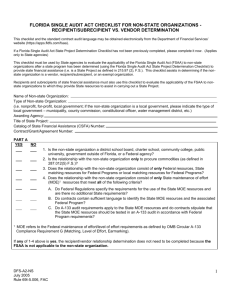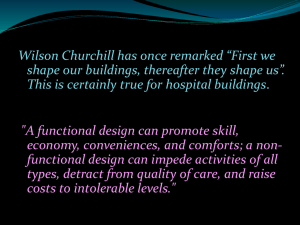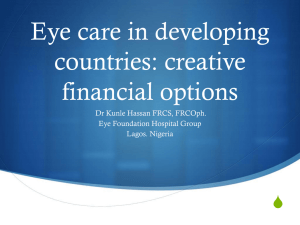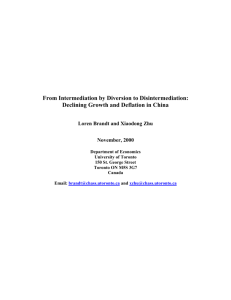ÁNH GIÁ TH*C TR*NG VÀ ** XU*T GI*I PHÁP NH*M T*NG C**NG
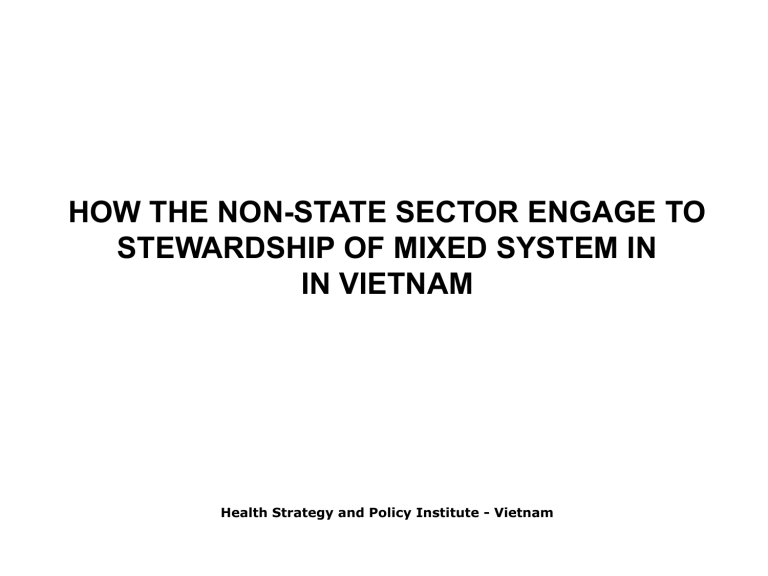
HOW THE NON-STATE SECTOR ENGAGE TO
STEWARDSHIP OF MIXED SYSTEM IN
IN VIETNAM
Health Strategy and Policy Institute - Vietnam
Content
1) Information on non-state sector in health in Vietnam
2) Models of engagement of NSP in health care system
3) Regulation for engaging NSP to the health care system
Information on non-state sector in Health in Vietnam
(1)
• Non-state health practice was officially recognized in 1989
• NSP legalized by Ordinance on
Private Pharmaceutical and
Medical practice in 1993
120
100
Non-state hospital in Vietnam
82
103
80
1998: 19.836 private health facilities (02 non-state hospitals)
2009: > 65,000 private health facilities:
- about 30,000 private medical facilities and 93 private hospitals
- 39,172 drug retails
60
40
48
20
0
14
0
2
1993 1998 2001 2005 2008 2010
Public-private mix of providers - Vietnam
Outpatient care Inpatient care
40% public
60% private
96% public
4% private
Information on non-state sector in Health in
Vietnam (2)
State and non-state hospital
1200
1000
800
600
400
200
0
3.3%
2004
1021
7.1%
2008
1081 State hospital
Non-state hospital
35 82
Proportion of total inpatients and outpatients treated by non-state hospitals
8,0%
7,0%
6,0%
5,0%
4,0%
3,0%
2,0%
1,0%
0,0%
4,8%
1,0%
2004
State and non-state hospital bed
160000
140000
120000
100000
80000
60000
40000
20000
0
State hospital
Non-state hospital
2.2%
2004
122206
2687
4.3%
2008
137813
6289
6,9%
3,2%
2008
Out-patients
In-patients
State sector is the main provider of hospital services
Non state sector engagement in delivering curative services (1)
Public hospitals • Strengths sign contract Expand availability of services for public hospitals with private health facilities to deliver paraclinical/hightech services
•
Increase accessibility of patients to health care services
Reduce problem of overload in public hospitals
Limitation/constraints
Difficult to control quality of services provided by private hospitals
Tendency of over use of services
Insured patients have to pay for extra-payment increase financial burden for patients
Engage in delivering curative services (2)
Public hospitals sign contract with private facilities to deliver nonmedical services
•
Mechanism: public hospitals sign contract with private facilities in providing services e.g. cleaning, laundering, hospital keepings, foods, water…
• Strengths
Reduce current expenditure
Professional
More cost-effectiveness
Engage in delivering curative services (3)
Engagement of
Non-state sector in term of investment within public hospital
• Joint activities with investors (medical equipment companies) to install machines and distribute profit gained based onthe capital pooled (investors pooled equipment and hospitals pooled their human resource, infrastructure)
• Investors installed machines and took monopoly in supplying chemicals, consumables investors installed machines and hospitals have to procure chemicals and consumables of the investors
Engage in delivering curative services (4)
Strengths
Limitations/ unexpected impacts
• Expanding types of healthcare services in diagnosis and treatment
‒ Increase number of patient contacts (1.3-1.5 times) and hospital admissions (1.2-1.4 times)
‒ Average number of lab tests/patient (1.3-2.1 times)
•Hospital revenue increases (1.9-2.1 times)
•Hospital staff’s income increases
•Tend to have service overuse to make profit by different ways
‒ Increase use of high tech laboratory tests and equipment
‒ Increasing hospital admission for inpatient care
‒ Irrational use of medicines.
‒ Lengthening hospitalization stay
•Increase treatment costs
•Problem of “public-private mixed” in public hospitals
Engage in delivering curative services (5)
NSP
Participate in
Health
Insurance scheme
Agency signs contract with private hospitals/ clinics (1)
• 276/7,918 (3.5%) private health facilities participate in health insurance scheme
• Types of services: 93.8% outpatients, 6.2% inpatients
• Strengths
Increase role of private sector in delivering health services
Increase accessibility of insured patients
Create competition between public and private health facilities
• Limitation/constraints
Number of private health facilities participate in the HI scheme still limited
Infrastructure, equipments, manpower of private health facilities still not adequate enough to sign contract with HI agency
Current policy and regulation related to NSP engaging in health system
-
-
Investment and establishment of Non state health care facilities
1993 : NSP recognized as a legal part of health care system (State ordinance 26, 1993, revised in 2003)
1999 : Social mobilization for health allowed private organization/individual participate in investment of health care activities not-for profit (Decree 73/1999)
Incentive for NS hospital: free land or rent without fee, free taxation in first 4 years, decrease by 50% in next 5 years. ( Resolution No.
46-NQ/TW & Decree No. 69/2008)
Targeting the side of non-state hospital by the year 2010: 2 beds/10,000 in 2010; 5 beds/10,000 in 2020
The licensing requirements based on the Law on Medical
Examination and Treatment of 2009 that will be applied for both state and non-state providers
Current policy and regulation related to NSP engaging in health system
Policy for NSP investment in state health facilities:
Hospital autonomy policy: Decree 10/2002, replaced by
Decree 43/2006:
1) Better health services delivery, improve quality and increase hospital revenues
2) Social mobilization of resources for health sectors in order to reduce subsidy from government to health facilities
• Social mobilization policy (Decree 73/1999, Decree No. 69/2008)
allowed public hospital to sign contract with private firms or individuals to invest in providing services (both clinical and non-clinical services)
Constrain in regulation
Lack of regulation to enforce non-state sector to provide public services:
– Disease surveillance, preventive cares
– Policy for involving non-state sector in providing services for vulnerable group
Lack of policy instrument to mmonitoring quality of services, patient care, satisfaction, outcomes (medical errors, overuse of services).
Constrain in regulation
Lack of mechanism to improve the engagement of non-state sector to public sector (PPP)
Weak role of professional/consumer organisations to oversight the performance of public facility in general, particularly for non-state sector.
Lack of health management information system for managing, monitoring and making plan for non-state sector development in the context of health system

